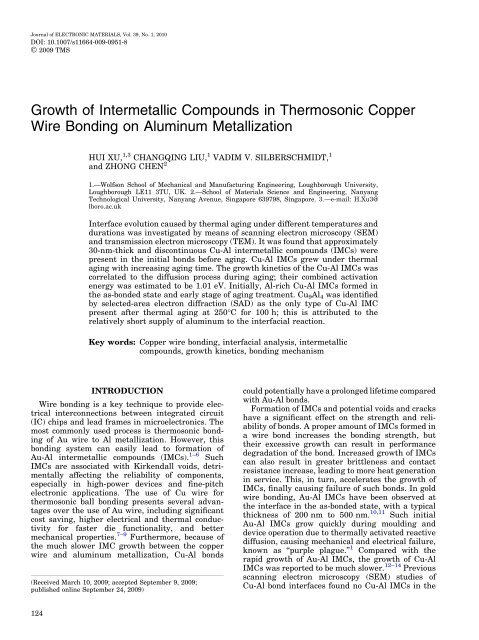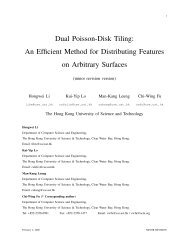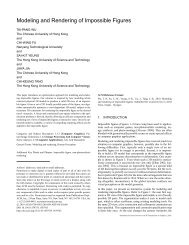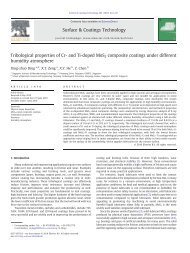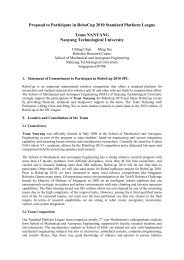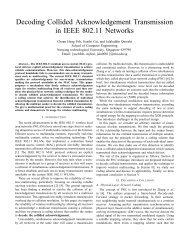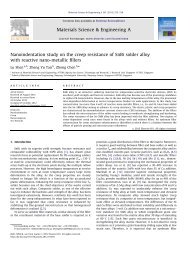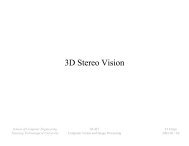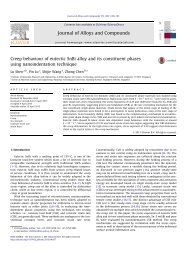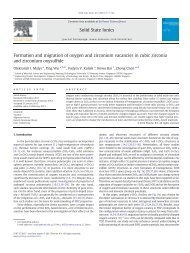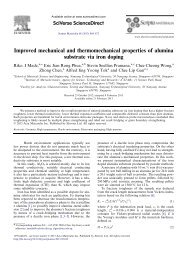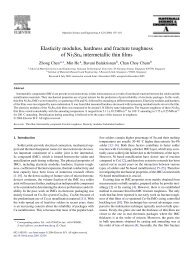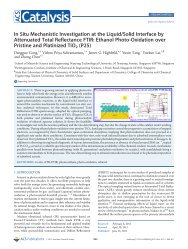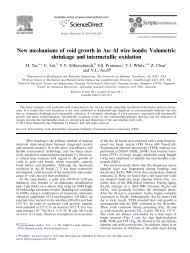Growth of Intermetallic Compounds in Thermosonic Copper Wire ...
Growth of Intermetallic Compounds in Thermosonic Copper Wire ...
Growth of Intermetallic Compounds in Thermosonic Copper Wire ...
Create successful ePaper yourself
Turn your PDF publications into a flip-book with our unique Google optimized e-Paper software.
Journal <strong>of</strong> ELECTRONIC MATERIALS, Vol. 39, No. 1, 2010<br />
DOI: 10.1007/s11664-009-0951-8<br />
Ó 2009 TMS<br />
<strong>Growth</strong> <strong>of</strong> <strong>Intermetallic</strong> <strong>Compounds</strong> <strong>in</strong> <strong>Thermosonic</strong> <strong>Copper</strong><br />
<strong>Wire</strong> Bond<strong>in</strong>g on Alum<strong>in</strong>um Metallization<br />
HUI XU, 1,3 CHANGQING LIU, 1 VADIM V. SILBERSCHMIDT, 1<br />
and ZHONG CHEN 2<br />
1.—Wolfson School <strong>of</strong> Mechanical and Manufactur<strong>in</strong>g Eng<strong>in</strong>eer<strong>in</strong>g, Loughborough University,<br />
Loughborough LE11 3TU, UK. 2.—School <strong>of</strong> Materials Science and Eng<strong>in</strong>eer<strong>in</strong>g, Nanyang<br />
Technological University, Nanyang Avenue, S<strong>in</strong>gapore 639798, S<strong>in</strong>gapore. 3.—e-mail: H.Xu3@<br />
lboro.ac.uk<br />
Interface evolution caused by thermal ag<strong>in</strong>g under different temperatures and<br />
durations was <strong>in</strong>vestigated by means <strong>of</strong> scann<strong>in</strong>g electron microscopy (SEM)<br />
and transmission electron microscopy (TEM). It was found that approximately<br />
30-nm-thick and discont<strong>in</strong>uous Cu-Al <strong>in</strong>termetallic compounds (IMCs) were<br />
present <strong>in</strong> the <strong>in</strong>itial bonds before ag<strong>in</strong>g. Cu-Al IMCs grew under thermal<br />
ag<strong>in</strong>g with <strong>in</strong>creas<strong>in</strong>g ag<strong>in</strong>g time. The growth k<strong>in</strong>etics <strong>of</strong> the Cu-Al IMCs was<br />
correlated to the diffusion process dur<strong>in</strong>g ag<strong>in</strong>g; their comb<strong>in</strong>ed activation<br />
energy was estimated to be 1.01 eV. Initially, Al-rich Cu-Al IMCs formed <strong>in</strong><br />
the as-bonded state and early stage <strong>of</strong> ag<strong>in</strong>g treatment. Cu9Al4 was identified<br />
by selected-area electron diffraction (SAD) as the only type <strong>of</strong> Cu-Al IMC<br />
present after thermal ag<strong>in</strong>g at 250°C for 100 h; this is attributed to the<br />
relatively short supply <strong>of</strong> alum<strong>in</strong>um to the <strong>in</strong>terfacial reaction.<br />
Key words: <strong>Copper</strong> wire bond<strong>in</strong>g, <strong>in</strong>terfacial analysis, <strong>in</strong>termetallic<br />
compounds, growth k<strong>in</strong>etics, bond<strong>in</strong>g mechanism<br />
INTRODUCTION<br />
<strong>Wire</strong> bond<strong>in</strong>g is a key technique to provide electrical<br />
<strong>in</strong>terconnections between <strong>in</strong>tegrated circuit<br />
(IC) chips and lead frames <strong>in</strong> microelectronics. The<br />
most commonly used process is thermosonic bond<strong>in</strong>g<br />
<strong>of</strong> Au wire to Al metallization. However, this<br />
bond<strong>in</strong>g system can easily lead to formation <strong>of</strong><br />
Au-Al <strong>in</strong>termetallic compounds (IMCs). 1–6 Such<br />
IMCs are associated with Kirkendall voids, detrimentally<br />
affect<strong>in</strong>g the reliability <strong>of</strong> components,<br />
especially <strong>in</strong> high-power devices and f<strong>in</strong>e-pitch<br />
electronic applications. The use <strong>of</strong> Cu wire for<br />
thermosonic ball bond<strong>in</strong>g presents several advantages<br />
over the use <strong>of</strong> Au wire, <strong>in</strong>clud<strong>in</strong>g significant<br />
cost sav<strong>in</strong>g, higher electrical and thermal conductivity<br />
for faster die functionality, and better<br />
mechanical properties. 7–9 Furthermore, because <strong>of</strong><br />
the much slower IMC growth between the copper<br />
wire and alum<strong>in</strong>um metallization, Cu-Al bonds<br />
(Received March 10, 2009; accepted September 9, 2009;<br />
published onl<strong>in</strong>e September 24, 2009)<br />
124<br />
could potentially have a prolonged lifetime compared<br />
with Au-Al bonds.<br />
Formation <strong>of</strong> IMCs and potential voids and cracks<br />
have a significant effect on the strength and reliability<br />
<strong>of</strong> bonds. A proper amount <strong>of</strong> IMCs formed <strong>in</strong><br />
a wire bond <strong>in</strong>creases the bond<strong>in</strong>g strength, but<br />
their excessive growth can result <strong>in</strong> performance<br />
degradation <strong>of</strong> the bond. Increased growth <strong>of</strong> IMCs<br />
can also result <strong>in</strong> greater brittleness and contact<br />
resistance <strong>in</strong>crease, lead<strong>in</strong>g to more heat generation<br />
<strong>in</strong> service. This, <strong>in</strong> turn, accelerates the growth <strong>of</strong><br />
IMCs, f<strong>in</strong>ally caus<strong>in</strong>g failure <strong>of</strong> such bonds. In gold<br />
wire bond<strong>in</strong>g, Au-Al IMCs have been observed at<br />
the <strong>in</strong>terface <strong>in</strong> the as-bonded state, with a typical<br />
thickness <strong>of</strong> 200 nm to 500 nm. 10,11 Such <strong>in</strong>itial<br />
Au-Al IMCs grow quickly dur<strong>in</strong>g mould<strong>in</strong>g and<br />
device operation due to thermally activated reactive<br />
diffusion, caus<strong>in</strong>g mechanical and electrical failure,<br />
known as ‘‘purple plague.’’ 1 Compared with the<br />
rapid growth <strong>of</strong> Au-Al IMCs, the growth <strong>of</strong> Cu-Al<br />
IMCs was reported to be much slower. 12–14 Previous<br />
scann<strong>in</strong>g electron microscopy (SEM) studies <strong>of</strong><br />
Cu-Al bond <strong>in</strong>terfaces found no Cu-Al IMCs <strong>in</strong> the
<strong>Growth</strong> <strong>of</strong> <strong>Intermetallic</strong> <strong>Compounds</strong> <strong>in</strong> <strong>Thermosonic</strong> <strong>Copper</strong> <strong>Wire</strong> Bond<strong>in</strong>g on Alum<strong>in</strong>um Metallization 125<br />
bonds <strong>in</strong> the as-bonded state. 12,13 Studies by Kim<br />
et al. showed that the growth rate <strong>of</strong> Cu-Al IMCs<br />
between the copper and Al-1% Si-0.5% Cu metallization<br />
was approximately 1/10 <strong>of</strong> that for Au-Al<br />
IMCs <strong>in</strong> the temperature range <strong>of</strong> 150°C to 300°C. 14<br />
The atomic properties <strong>of</strong> the elements (i.e., copper,<br />
gold, and alum<strong>in</strong>um) could be used to expla<strong>in</strong> the<br />
large difference <strong>in</strong> the growth rates <strong>of</strong> IMCs. Compared<br />
with an atom <strong>of</strong> Au, an atom <strong>of</strong> Cu has a<br />
larger size misfit with alum<strong>in</strong>um and lower electronegativity,<br />
thus mak<strong>in</strong>g the formation <strong>of</strong> Cu-Al<br />
IMCs much more difficult than the formation <strong>of</strong><br />
Au-Al IMCs. 13 However, the k<strong>in</strong>etics <strong>of</strong> Cu-Al IMCs,<br />
<strong>in</strong>clud<strong>in</strong>g their activation energy, <strong>in</strong> thermosonic<br />
Cu-Al bonds was not clearly documented, although<br />
there were some studies on bulk and th<strong>in</strong>-film Cu-Al<br />
couples. 15–19<br />
Different IMCs can be formed at the <strong>in</strong>terface and<br />
affect the reliability <strong>of</strong> bonds. IMCs with high melt<strong>in</strong>g<br />
po<strong>in</strong>ts (e.g., above 1000°C) are stable at <strong>in</strong>terfaces<br />
and should not significantly affect reliability. IMCs<br />
with low melt<strong>in</strong>g po<strong>in</strong>ts (e.g., below 500°C) are less<br />
stable and their constituents will cont<strong>in</strong>ue to diffuse,<br />
which can affect reliability. Accord<strong>in</strong>g to<br />
the b<strong>in</strong>ary phase diagram <strong>of</strong> the Cu-Al system,<br />
five IMCs—CuAl2 (h phase), CuAl (g2 phase), Cu4Al3<br />
(f2 phase), Cu3Al2 (d phase), and Cu9Al4 (c2 phase)—<br />
can exist at temperatures below 300°C.<br />
Previously, studies <strong>of</strong> the <strong>in</strong>terfacial behavior <strong>of</strong><br />
Cu-Al bonds were mostly carried out us<strong>in</strong>g optical<br />
microscopy (OM) and SEM with an energy-dispersive<br />
x-ray spectrometer (EDX). 10–13<br />
It should be<br />
noted that these techniques are not able to provide<br />
detailed <strong>in</strong>formation on crystallographic structure,<br />
therefore the expected <strong>in</strong>termetallic phases <strong>in</strong> Cu-Al<br />
bonds were not clearly identified. Transmission<br />
electron microscopy (TEM) is able to analyze the<br />
Cu-Al bond <strong>in</strong>terface on the nanoscale and identify<br />
its crystallographic structure. The ma<strong>in</strong> challenge<br />
for TEM analysis <strong>of</strong> a wire bond is associated with<br />
specimen preparation s<strong>in</strong>ce region-specific analysis<br />
is necessary. In addition, conventional specimen<br />
preparation can result <strong>in</strong> mechanical damage <strong>of</strong> the<br />
<strong>in</strong>terface region dur<strong>in</strong>g polish<strong>in</strong>g. These problems<br />
can be overcome by us<strong>in</strong>g a dual-beam focused ion<br />
beam (FIB) system, which comb<strong>in</strong>es SEM with a<br />
scann<strong>in</strong>g ion beam. In this way specific regions can<br />
be located us<strong>in</strong>g SEM, and TEM specimen prepared<br />
without the application <strong>of</strong> mechanical forces.<br />
In this paper, we report the <strong>in</strong>terfacial morphology<br />
<strong>of</strong> copper bonds on alum<strong>in</strong>um metallization <strong>in</strong><br />
the as-bonded state, followed by the growth characteristics<br />
<strong>of</strong> Cu-Al IMCs at high temperatures and<br />
extended ag<strong>in</strong>g times. The growth k<strong>in</strong>etics <strong>of</strong> Cu-Al<br />
IMCs is exam<strong>in</strong>ed as well as the effect <strong>of</strong> ag<strong>in</strong>g<br />
temperature and time on the morphology <strong>of</strong> IMCs.<br />
F<strong>in</strong>ally, the <strong>in</strong>termetallic compounds <strong>in</strong> the bonds<br />
are identified by selected-area electron diffraction<br />
(SAD) on specimens prepared by a dual-beam FIB<br />
system. We also attempt to elucidate the mechanism<br />
<strong>of</strong> <strong>in</strong>terfacial reaction between the copper wire<br />
and alum<strong>in</strong>um metallization dur<strong>in</strong>g the bond<strong>in</strong>g<br />
process and thermal ag<strong>in</strong>g.<br />
EXPERIMENTAL PROCEDURES<br />
In our experimental studies, a copper wire<br />
(99.99 wt.%) with a diameter <strong>of</strong> 50.8 lm was bonded<br />
to a 3-lm-thick Al metallization pad on a silicon<br />
chip us<strong>in</strong>g an ASM Eagle 60 ball/wedge automatic<br />
bonder with an ultrasonic frequency <strong>of</strong> 138 kHz. An<br />
electronic flame-<strong>of</strong>f (EFO) process was applied to<br />
produce a spherical ball at the end <strong>of</strong> copper wire as<br />
the first step <strong>of</strong> the bond<strong>in</strong>g cycle. The <strong>in</strong>itial copper<br />
ball was achieved with a current <strong>of</strong> 150 mA and a<br />
gap voltage <strong>of</strong> 5500 V with a discharge time <strong>of</strong><br />
1.3 ms. In order to prevent the copper ball from<br />
oxidiz<strong>in</strong>g <strong>in</strong> the EFO process, a protective shield<strong>in</strong>g<br />
gas—95% N2 +5% H2—was supplied and ma<strong>in</strong>ta<strong>in</strong>ed<br />
at a flow rate <strong>of</strong> 0.8 L/m<strong>in</strong>. The copper ball<br />
was then bonded to alum<strong>in</strong>um metallization us<strong>in</strong>g a<br />
comb<strong>in</strong>ation <strong>of</strong> heat, transverse ultrasonic vibration,<br />
and normal force. The detailed bond<strong>in</strong>g<br />
parameters are shown <strong>in</strong> Table I for the process<br />
w<strong>in</strong>dow optimized by means <strong>of</strong> pull/shear tests and<br />
dimension tests.<br />
In order to accelerate <strong>in</strong>terfacial evolution and<br />
ascerta<strong>in</strong> the growth k<strong>in</strong>etics <strong>of</strong> Cu-Al IMCs, samples<br />
were thermally aged at 200°C for up to<br />
121 days, at 250°C for up to 169 h, and at 300°C for<br />
up to 16 h <strong>in</strong> nitrogen.<br />
After thermal ag<strong>in</strong>g, cross-sectional samples were<br />
prepared for SEM observation <strong>of</strong> IMC morphology.<br />
Back-scatter electron (BSE) SEM images were<br />
taken <strong>in</strong> order to highlight the presence <strong>of</strong> different<br />
layers (i.e., Al, Cu-Al IMCs, and Cu). The common<br />
metallographic procedure was performed to reveal<br />
the cross-sectional microstructure: the bonds were<br />
wet-ground with grit size 400, 600, 1000, and 2000<br />
sandpaper, followed by polish<strong>in</strong>g with 1.0-lm and<br />
0.25-lm diamond suspensions on silk cloths. SEM<br />
observations were performed us<strong>in</strong>g a HITACHI<br />
S-4700 system. The average thickness <strong>of</strong> the IMCs<br />
was obta<strong>in</strong>ed for each sample by measur<strong>in</strong>g the<br />
cross-sectional area <strong>of</strong> the layer over a certa<strong>in</strong><br />
length on the SEM image us<strong>in</strong>g an image analyzer.<br />
The microstructure <strong>of</strong> the Cu-Al bonds both <strong>in</strong> the<br />
as-bonded state and after thermal ag<strong>in</strong>g were<br />
<strong>in</strong>vestigated by cross-sectional TEM comb<strong>in</strong>ed with<br />
EDX. The TEM samples were prepared us<strong>in</strong>g FIB<br />
with a lift-out technique. 14 Mo lift-out TEM grids<br />
were used to avoid x-ray energy overlaps with Cu.<br />
TEM analysis was carried out us<strong>in</strong>g the JEOL<br />
2100F system at 200 kV. A microprobe beam <strong>of</strong><br />
Table I. Optimized bond<strong>in</strong>g parameters<br />
Ultrasonic power (DAC) 90<br />
Bond<strong>in</strong>g force (gf) 110<br />
Bond<strong>in</strong>g time (ms) 28<br />
Bond<strong>in</strong>g temperature (°C) 220
126<br />
Fig. 1. SEM image <strong>of</strong> typical copper wire ball bonds formed by<br />
thermosonic bond<strong>in</strong>g on alum<strong>in</strong>um metallization on an IC.<br />
approximately 1 nm diameter was used for composition<br />
analysis with EDX. TEM–SAD was performed<br />
to identify the type and structure <strong>of</strong> Cu-Al IMCs.<br />
RESULTS AND DISCUSSION<br />
Interfacial Morphology <strong>of</strong> Cu-Al Bonds<br />
<strong>in</strong> As-Bonded State<br />
Cu-Al bonds need to withstand thermal and<br />
electrical impacts dur<strong>in</strong>g device operation, especially<br />
at the <strong>in</strong>terface; their <strong>in</strong>itial states and morphology<br />
are the key factors for their reliability. 1<br />
Figure 1 shows typical copper-wire ball bonds on<br />
alum<strong>in</strong>um metallization obta<strong>in</strong>ed by means <strong>of</strong><br />
thermosonic bond<strong>in</strong>g with optimized parameters<br />
(Table I). The failure <strong>in</strong> the shear test typically<br />
occurs <strong>in</strong> the mashed copper ball rather than at the<br />
<strong>in</strong>terface between the ball and the alum<strong>in</strong>um metallization<br />
pad (Fig. 2); <strong>in</strong> the pull test it typically<br />
occurs as a neck break (Fig. 3), <strong>in</strong>dicat<strong>in</strong>g that the<br />
Cu-Al bond has high strength.<br />
In order to ascerta<strong>in</strong> the <strong>in</strong>terfacial characteristics<br />
<strong>of</strong> Cu-Al bonds <strong>in</strong> the as-bonded state, SEM and<br />
TEM were employed. A cross-sectional SEM image<br />
(Fig. 4) shows no visible IMCs at the <strong>in</strong>terface at<br />
such magnification. However, at higher resolution,<br />
the bright-field (BF) TEM image (Fig. 5) shows<br />
IMCs particles formed between alum<strong>in</strong>um and<br />
copper. Those discont<strong>in</strong>uous IMC particles are<br />
approximately 30 nm thick. Based on our previous<br />
work, this very <strong>in</strong>itial phase is CuAl2. 20<br />
Previous studies <strong>of</strong> Au-Al bonds based on SEM<br />
and TEM observations revealed a 200-nm- to<br />
500-nm-thick Au-Al IMC layer formed at the<br />
<strong>in</strong>terface dur<strong>in</strong>g the thermosonic bond<strong>in</strong>g stage<br />
(175°C), 10,11 although the mechanism <strong>of</strong> formation<br />
<strong>of</strong> Au-Al IMCs with<strong>in</strong> several milliseconds<br />
rema<strong>in</strong>s unclear. As for Cu-Al bonds, the above<br />
morphological analysis showed only approximately<br />
30-nm-thick and discont<strong>in</strong>uous Cu-Al IMCs at the<br />
Xu, Liu, Silberschmidt, and Chen<br />
Fig. 2. Failure <strong>in</strong> mashed copper balls after shear test show<strong>in</strong>g high<br />
strength <strong>of</strong> Cu-Al bonds (average shear force 145 gf).<br />
Fig. 3. Failure <strong>in</strong> necks after pull test, confirm<strong>in</strong>g good bondability<br />
(average pull force 41 gf).<br />
Fig. 4. Cross-sectional SEM image <strong>of</strong> Cu/Al <strong>in</strong>terface <strong>in</strong> the asbonded<br />
state.<br />
<strong>in</strong>terface. No voids were observed near the Cu-Al<br />
<strong>in</strong>terface; as reported, some nanolevel voids were<br />
found <strong>in</strong>side the Au-Al IMCs for the Au-Al system. 11
<strong>Growth</strong> <strong>of</strong> <strong>Intermetallic</strong> <strong>Compounds</strong> <strong>in</strong> <strong>Thermosonic</strong> <strong>Copper</strong> <strong>Wire</strong> Bond<strong>in</strong>g on Alum<strong>in</strong>um Metallization 127<br />
Fig. 5. BF TEM image present<strong>in</strong>g morphology <strong>of</strong> <strong>in</strong>terface region <strong>of</strong><br />
Cu-Al bond.<br />
The real <strong>in</strong>terfacial temperature dur<strong>in</strong>g the<br />
bond<strong>in</strong>g process is expected to account for the<br />
bond<strong>in</strong>g mechanism (at least to some extent).<br />
The temperature rises up to 320°C based on <strong>in</strong> situ<br />
measurements us<strong>in</strong>g th<strong>in</strong>-film thermocouples fabricated<br />
by sputter<strong>in</strong>g deposition. 21 Based on the<br />
Kuhlmann–Wilsdorf’s flash temperature model and<br />
the theoretical analysis <strong>of</strong> frictional energy <strong>in</strong>tensity<br />
and real contact area, the calculated magnitude<br />
<strong>of</strong> the temperature rise dur<strong>in</strong>g the bond<strong>in</strong>g was not<br />
more than 321°C. 22 Meanwhile, the morphology <strong>of</strong><br />
the Cu-Al <strong>in</strong>terface (Figs. 4 and 5) shows no traces<br />
<strong>of</strong> melt<strong>in</strong>g, so it can be assumed that thermosonic<br />
copper bond<strong>in</strong>g is a solid-state process.<br />
It is well known that the relative motion <strong>in</strong>duced<br />
by ultrasonic vibration at the <strong>in</strong>terface plays a very<br />
important role <strong>in</strong> ultrasonic bond<strong>in</strong>g. 1 It can break<br />
down surface contam<strong>in</strong>ants and oxides. Thus, pure<br />
contact <strong>in</strong>terfaces are partially exposed and contacted;<br />
<strong>in</strong>terconnection is the result <strong>of</strong> IMCs form<strong>in</strong>g<br />
dur<strong>in</strong>g the bond<strong>in</strong>g process due to atomic <strong>in</strong>terdiffusion.<br />
Cu-Al IMCs <strong>Growth</strong> K<strong>in</strong>etics Dur<strong>in</strong>g Thermal<br />
Ag<strong>in</strong>g<br />
To study the growth behavior <strong>of</strong> Cu-Al IMCs,<br />
thermal ag<strong>in</strong>g with different temperatures and<br />
durations was performed; the respective crosssectional<br />
BSE SEM images are shown <strong>in</strong> Figs. 6–8.<br />
The basic structures observed at the central <strong>in</strong>terface<br />
are the layers <strong>of</strong> IMCs between the copper wire<br />
and alum<strong>in</strong>um metallization which emerged due to<br />
thermal ag<strong>in</strong>g. The types <strong>of</strong> IMCs and their formation<br />
sequence will be briefly discussed <strong>in</strong> the follow<strong>in</strong>g<br />
section. In this section, IMC thicken<strong>in</strong>g is<br />
Fig. 6. Cross-sectional BSE SEM <strong>of</strong> copper ball/Al metallization<br />
<strong>in</strong>terfaces after ag<strong>in</strong>g at 200°C for: (a) 1 day, very small IMCs<br />
formed; (b) 4 days, a layer <strong>of</strong> IMCs formed; (c) 64 days, thicker<br />
IMCs; and (d) 121 days, 1.5-lm-thick IMCs formed.<br />
observed and quantified based on the total thickness<br />
<strong>of</strong> IMCs at the <strong>in</strong>terface. As a result, the k<strong>in</strong>etics<br />
data obta<strong>in</strong>ed are apparent ones based on comb<strong>in</strong>ed<br />
IMC growth behavior.<br />
Figure 6a–d presents cross-sectional BSE SEM<br />
images <strong>of</strong> Cu-Al IMCs formed after thermal ag<strong>in</strong>g at<br />
200°C. Very little Cu-Al IMCs were observed at the<br />
<strong>in</strong>terface after 1 day <strong>of</strong> ag<strong>in</strong>g (Fig. 6a). Cu-Al IMCs<br />
thickened when thermal ag<strong>in</strong>g cont<strong>in</strong>ued but with a<br />
low growth rate (Fig. 6b, c). Their thickness reached<br />
1.5 lm after a long exposure, i.e., 121 days<br />
(Fig. 6d).<br />
When aged at 250°C, as shown <strong>in</strong> Fig. 7a–d, IMCs<br />
grew much faster than at 200°C. Evidently, the<br />
layers <strong>of</strong> IMCs have formed after 25 h <strong>of</strong> ag<strong>in</strong>g. Al<br />
metallization was consumed due to its reaction with<br />
copper, and it completely disappeared after 169 h.<br />
The morphological changes that occurred dur<strong>in</strong>g<br />
thermal ag<strong>in</strong>g at 300°C are shown <strong>in</strong> Fig. 8a–d. The<br />
IMCs became obvious at the Cu/Al <strong>in</strong>terface even<br />
after only 1 h <strong>of</strong> ag<strong>in</strong>g, and IMCs <strong>in</strong>creased rapidly
128<br />
Fig. 7. Cross-sectional BSE SEM images <strong>of</strong> copper ball/Al metallization<br />
<strong>in</strong>terfaces after ag<strong>in</strong>g at 250°C for: (a) 1 h; (b) 25 h; (c) 100 h;<br />
and (d) 169 h. Al metallization th<strong>in</strong>ned with <strong>in</strong>creas<strong>in</strong>g time and<br />
disappeared after 169 h.<br />
with thermal treatment. Alum<strong>in</strong>um metallization<br />
was almost consumed after only 16 h.<br />
In a solid-state reaction analysis, the thickness x<br />
<strong>of</strong> IMCs at ag<strong>in</strong>g time t was estimated us<strong>in</strong>g the<br />
follow<strong>in</strong>g equation 15 :<br />
x x1 ¼ ðKtÞ 1=n ; (1)<br />
where K is the growth rate constant, x 1 is a constant<br />
related to the <strong>in</strong>itial IMC thickness, and n is the<br />
time <strong>in</strong>dex.<br />
The magnitude <strong>of</strong> the growth rate constant <strong>of</strong><br />
IMCs changes for different types <strong>of</strong> Cu-Al IMCs; it<br />
also depends on the neighbor<strong>in</strong>g phases, which<br />
supply additional Cu and/or Al for cont<strong>in</strong>ued compound<br />
formation. However, it is extremely difficult<br />
to measure the thickness <strong>of</strong> each <strong>in</strong>dividual IMC<br />
layer, as they <strong>in</strong>tertw<strong>in</strong>e with each other. Therefore,<br />
a comb<strong>in</strong>ed growth rate constant and activation<br />
energy for all potential Cu-Al IMCs formed <strong>in</strong> bonds<br />
were <strong>in</strong>troduced. Figure 9 shows the thickness <strong>of</strong><br />
Xu, Liu, Silberschmidt, and Chen<br />
Fig. 8. Cross-sectional BSE SEM images <strong>of</strong> Cu-Al samples aged at<br />
300°C for: (a) 1 h; (b) 4 h; (c) 9 h; and (d) 16 h.<br />
Cu-Al IMCs for samples aged for various times at<br />
200°C, 250°C, and 300°C. In general, the solid-state<br />
growth <strong>of</strong> IMCs can follow l<strong>in</strong>ear or parabolic<br />
growth k<strong>in</strong>etics. L<strong>in</strong>ear growth implies that the<br />
growth rate is limited by the reaction rate at growth<br />
sites. In contrast, parabolic growth implies that the<br />
growth is controlled by diffusion. It is obvious from<br />
Fig. 9 that the growth <strong>of</strong> IMCs follows a parabolic<br />
law (n = 2), suggest<strong>in</strong>g that the Cu-Al IMCs growth<br />
dur<strong>in</strong>g thermal ag<strong>in</strong>g is a diffusion-controlled process.<br />
Cu-Al IMCs grew faster at the earlier stage <strong>of</strong><br />
ag<strong>in</strong>g, and the process was more sensitive to the<br />
ag<strong>in</strong>g temperature than to the ag<strong>in</strong>g time. The<br />
growth rate constants for Cu-Al IMCs (Table II)<br />
were calculated from the fitted parabolas <strong>in</strong> Fig. 9.<br />
Accord<strong>in</strong>g to the classic k<strong>in</strong>etic theory, the value<br />
<strong>of</strong> K is characterized by the temperature and activation<br />
energy, and it can be given by the Arrhenius<br />
equation 17,23,24 :<br />
K ¼ K0 exp<br />
Q<br />
RT<br />
; (2)
<strong>Growth</strong> <strong>of</strong> <strong>Intermetallic</strong> <strong>Compounds</strong> <strong>in</strong> <strong>Thermosonic</strong> <strong>Copper</strong> <strong>Wire</strong> Bond<strong>in</strong>g on Alum<strong>in</strong>um Metallization 129<br />
Fig. 9. Cu-Al IMC growth <strong>in</strong> Cu-Al bonds under different thermal<br />
ag<strong>in</strong>g times and temperatures.<br />
Table II. <strong>Growth</strong> rate constants for IMCs <strong>in</strong> Cu-Al<br />
bonds at different temperatures<br />
T, Temperature (°C)<br />
K, <strong>Growth</strong> Rate Constants<br />
for Cu-Al IMCs (m 2 /s)<br />
200 2.27 9 10 18<br />
250 2.46 9 10 17<br />
300 1.67 9 10 16<br />
where K 0 is a prefactor, Q is the activation energy<br />
for <strong>in</strong>termetallic growth, R is the molar gas constant,<br />
and T is absolute temperature.<br />
An Arrhenius plot, as shown <strong>in</strong> Fig. 10, is<br />
obta<strong>in</strong>ed from the data <strong>in</strong> Table II. The activation<br />
energy, Q, can be calculated from the slope <strong>of</strong> a<br />
curve <strong>of</strong> ln K versus 1/T. The obta<strong>in</strong>ed activation<br />
energy was 1.01 eV, which was different from the<br />
reported activation energy, 1.14 eV to 1.43 eV,<br />
obta<strong>in</strong>ed for the bulk Cu/Al diffusion couples. 25,26<br />
A lower activation energy is generally considered<br />
an <strong>in</strong>dication <strong>of</strong> the formation <strong>of</strong> IMCs by shortcircuit<br />
diffusion via structural defects such as gra<strong>in</strong><br />
boundaries and dislocations. Actually, the atomic<br />
diffusion <strong>of</strong> Cu and Al through the IMCs is the ma<strong>in</strong><br />
def<strong>in</strong><strong>in</strong>g process for the IMCs growth dur<strong>in</strong>g thermal<br />
ag<strong>in</strong>g. Dur<strong>in</strong>g diffusion, one atom moves <strong>in</strong>to an<br />
empty lattice position (vacancy), and another atom<br />
moves <strong>in</strong>to the empty position <strong>of</strong> the first. Therefore,<br />
the diffusion rate <strong>of</strong> one metal <strong>in</strong>to another is<br />
dependent on the number <strong>of</strong> defects (e.g., vacancies,<br />
dislocations, and gra<strong>in</strong> boundaries) <strong>in</strong> the crystal<br />
lattice. The more defects it has, the faster the diffusion<br />
processes. The thermosonic bond<strong>in</strong>g process<br />
results <strong>in</strong> numerous lattice defects for Cu-Al bonds<br />
due to large plastic deformations and high stresses,<br />
thus, <strong>in</strong>terdiffusion <strong>in</strong> thermosonic bonds is more<br />
rapid than <strong>in</strong> bulk Cu/Al couples; this expla<strong>in</strong>s the<br />
Fig. 10. ln K versus 1/T dependence.<br />
Fig. 11. TEM image present<strong>in</strong>g two layers <strong>of</strong> IMCs <strong>in</strong> Cu-Al bond<br />
after thermal ag<strong>in</strong>g at 250°C for 1 h.<br />
lower activation energy <strong>of</strong> Cu-Al IMCs <strong>in</strong> thermosonic<br />
Cu-Al bonds. As a consequence, poorly bonded<br />
bonds would fail more rapidly as IMCs grow more<br />
quickly.<br />
Identification <strong>of</strong> Cu-Al IMCs<br />
Figure 11 presents a BF TEM image <strong>of</strong> the<br />
<strong>in</strong>terface region <strong>of</strong> a Cu-Al bond after thermal ag<strong>in</strong>g<br />
for 1 h at 250°C. Two layers <strong>of</strong> IMCs are clearly<br />
observed between copper and alum<strong>in</strong>um.<br />
STEM–EDX was conducted to identify these IMC<br />
layers. The results <strong>of</strong> EDX given <strong>in</strong> Table III from
130<br />
Table III. STEM–EDX results <strong>of</strong> regions 1–6 <strong>in</strong><br />
Fig. 11<br />
Regions O K (at.%) Al K (at.%) Cu K (at.%)<br />
1 10.8 46.2 43.0<br />
2 9.9 46.7 43.4<br />
3 11.1 26.5 62.4<br />
4 12.1 27.2 60.6<br />
5 48.9 31.0 20.2<br />
6 40.5 37.2 22.3<br />
Fig. 12. TEM image <strong>of</strong> a Cu-Al bond after thermal ag<strong>in</strong>g at 250°C for<br />
100 h.<br />
regions 1 and 2 <strong>of</strong> the IMC-1 layer <strong>in</strong>dicate that the<br />
ratio <strong>of</strong> Cu to Al was close to 1:1; however, an<br />
approximate 9:4 Cu-to-Al ratio was found <strong>in</strong><br />
regions 3 and 4 <strong>of</strong> the IMC-2 layer. Therefore, the<br />
two types <strong>of</strong> IMCs (CuAl and Cu 9Al 4) existed <strong>in</strong> the<br />
layers <strong>of</strong> IMC-1 and IMC-2, respectively. It was also<br />
found with EDX that oxygen is relatively rich at the<br />
<strong>in</strong>terface between the two IMCs (approximately<br />
40 at.% to 50 at.%) <strong>in</strong> comparison with <strong>in</strong>side the<br />
IMCs (approximately 10 at.%).<br />
A TEM image <strong>of</strong> a sample after thermal ag<strong>in</strong>g for<br />
100 h at 250°C is shown <strong>in</strong> Fig. 12. Two thicker<br />
layers <strong>of</strong> IMCs existed between the copper and<br />
alum<strong>in</strong>um.<br />
L<strong>in</strong>e-scann<strong>in</strong>g TEM–EDX analysis was conducted<br />
across those two layers <strong>of</strong> Cu-Al IMCs, and the<br />
results are shown <strong>in</strong> Fig. 13. As there are no changes<br />
<strong>in</strong> the composition between the two layers <strong>of</strong><br />
IMCs, it <strong>in</strong>dicates that there could be only one type<br />
<strong>of</strong> IMC between the Cu and Al. The decrease <strong>of</strong><br />
<strong>in</strong>tensity <strong>of</strong> all elements at the <strong>in</strong>terface between<br />
Xu, Liu, Silberschmidt, and Chen<br />
Fig. 13. Results <strong>of</strong> l<strong>in</strong>e-scann<strong>in</strong>g TEM–EDX across two layers <strong>of</strong><br />
IMCs <strong>in</strong> Fig. 12.<br />
Fig. 14. SAD patterns <strong>of</strong> (a) IMC-1 and (b) IMC-2 <strong>in</strong> Fig. 12.<br />
the two layers <strong>of</strong> IMCs <strong>in</strong>dicates the presence <strong>of</strong><br />
voids.<br />
Due to the <strong>in</strong>ability to identify the crystallographic<br />
structure by means <strong>of</strong> TEM–EDX analysis,<br />
further <strong>in</strong>vestigation was carried out by TEM–SAD,<br />
with two diffraction patterns <strong>of</strong> Cu-Al IMCs for the<br />
sample aged at 250°C for 100 h presented <strong>in</strong><br />
Fig. 14a and b. Cu9Al4 (p-43m, a = 0.870 nm) was<br />
identified as the phase for both IMC layers. For the<br />
sample aged at 250°C for 1 h, SAD results showed<br />
that both IMCs are polycrystall<strong>in</strong>e, although further<br />
identification is still ongo<strong>in</strong>g. However, it<br />
should be noted that STEM–EDX suggested that<br />
two layers <strong>of</strong> IMCs might be CuAl and Cu 9Al 4,<br />
respectively. Previous work <strong>in</strong>vestigat<strong>in</strong>g <strong>in</strong>terdiffusion<br />
<strong>in</strong> bulk copper–alum<strong>in</strong>um couples detected<br />
all five equilibrium phases by microprobe analysis,<br />
15 and observed CuAl2, CuAl and Cu9Al4 <strong>in</strong> th<strong>in</strong>film<br />
copper–alum<strong>in</strong>um couples. 16,17<br />
The presence <strong>of</strong> specific <strong>in</strong>termetallic phases can<br />
depend on the relative amounts <strong>of</strong> metals present <strong>in</strong><br />
the <strong>in</strong>itial composition. Bulk copper–alum<strong>in</strong>um<br />
couples and th<strong>in</strong>-film couples with vary<strong>in</strong>g relative<br />
amounts <strong>of</strong> metals could produce different compounds.<br />
Consequently, for copper bonds on alum<strong>in</strong>um<br />
metallization, the amount <strong>of</strong> copper is much<br />
higher than that <strong>of</strong> alum<strong>in</strong>um, produc<strong>in</strong>g copperrich<br />
IMCs, i.e., Cu9Al4. However, it is possible that<br />
other phases are <strong>in</strong>itially formed at the early stage<br />
<strong>of</strong> diffusion but are dissolved or transferred to another<br />
phase when one <strong>of</strong> the materials is consumed<br />
<strong>in</strong> the diffusion process or reaction. We believe that,
<strong>Growth</strong> <strong>of</strong> <strong>Intermetallic</strong> <strong>Compounds</strong> <strong>in</strong> <strong>Thermosonic</strong> <strong>Copper</strong> <strong>Wire</strong> Bond<strong>in</strong>g on Alum<strong>in</strong>um Metallization 131<br />
<strong>in</strong> our Cu-Al bonded samples, CuAl 2 was the <strong>in</strong>itial<br />
phase formed at scattered sites <strong>of</strong> the <strong>in</strong>terface.<br />
Upon ag<strong>in</strong>g treatment, CuAl phase formed as a<br />
result <strong>of</strong> more Cu diffusion through the <strong>in</strong>terface. At<br />
the same time Cu9Al4 started to form adjacent to the<br />
Cu side, probably due to the relative ease <strong>of</strong> its<br />
nucleation. Once the th<strong>in</strong> Al layer was fully consumed,<br />
the CuAl phase transformed <strong>in</strong>to Cu9Al4.<br />
This is evidenced by the coexistence <strong>of</strong> CuAl and<br />
Cu 9Al 4 <strong>in</strong> the sample aged at 250°C for 1 h (Fig. 11).<br />
However, CuAl f<strong>in</strong>ally transformed <strong>in</strong>to Cu9Al4<br />
when alum<strong>in</strong>um was consumed after 100 h<br />
(Fig. 12).<br />
CONCLUSIONS<br />
TEM studies <strong>of</strong> <strong>in</strong>terfacial features <strong>of</strong> Cu-Al bonds<br />
<strong>in</strong> the as-bonded state showed that approximately<br />
30-nm-thick and discont<strong>in</strong>uous Cu-Al IMCs were<br />
formed. Thus, thermosonic copper wire bond<strong>in</strong>g on<br />
alum<strong>in</strong>um metallization is proposed to be metallurgical<br />
and chemical bond<strong>in</strong>g.<br />
The evolution <strong>of</strong> Cu-Al IMCs was observed as a<br />
result <strong>of</strong> thermal ag<strong>in</strong>g <strong>of</strong> Cu-Al bonds. The growth<br />
<strong>of</strong> IMCs was found to follow a parabolic law, <strong>in</strong>dicat<strong>in</strong>g<br />
that it was controlled by the diffusion<br />
mechanism. The comb<strong>in</strong>ed activation energy calculated<br />
for the growth <strong>of</strong> Cu-Al IMCs was 1.01 eV,<br />
which is smaller than reported values obta<strong>in</strong>ed for<br />
bulk Cu/Al diffusion couples. An explanation was<br />
given based on the fact that more defects were<br />
generated <strong>in</strong> the thermosonic bond<strong>in</strong>g process,<br />
lead<strong>in</strong>g to faster <strong>in</strong>terdiffusion <strong>in</strong> Cu-Al bonds.<br />
Two types <strong>of</strong> Cu-Al IMCs (CuAl and Cu9Al4) were<br />
present after 1 h <strong>of</strong> ag<strong>in</strong>g at 250°C. However,<br />
Cu9Al4 was identified as the only IMC after 100 h <strong>of</strong><br />
ag<strong>in</strong>g at 250°C. Analysis showed that the relative<br />
short supply <strong>of</strong> alum<strong>in</strong>um could be the cause <strong>of</strong><br />
formation <strong>of</strong> copper-rich IMCs, i.e., Cu9Al4.<br />
ACKNOWLEDGEMENTS<br />
This paper is an output <strong>of</strong> the PMI2 Project<br />
funded by the UK Department for Innovation,<br />
Universities, and Skills (DIUS) for the benefit <strong>of</strong> the<br />
S<strong>in</strong>gapore Higher Education Sector and the UK<br />
Higher Education Sector. Authors would also like to<br />
acknowledge Dr. Ge<strong>of</strong>f West, Mr. John Bates, and<br />
Mr. Honghui Wang for their assistance with<br />
experiments.<br />
1.<br />
REFERENCES<br />
G.G. Harman, <strong>Wire</strong> Bond<strong>in</strong>g <strong>in</strong> Microelectronics, Materials,<br />
Processes, Reliability, and Yield, 2nd ed. (New York:<br />
2.<br />
McGraw-Hill, 1997).<br />
E. Phil<strong>of</strong>sky, Solid State Electron. 13, 1391 (1970).<br />
3. G.Y. Jang, J.G. Duh, H. Takahashi, and D. Su, J. Electron.<br />
Mater. 35, 323 (2006).<br />
4. H. Ji, M. Li, C. Wang, and H.S. Bang, Mater. Sci. Eng. A<br />
447, 111 (2007).<br />
5. H.S. Chang, J.X. Pon, K.C. Hsieh, and C.C. Chen, J. Electron.<br />
Mater. 30, 1171 (2001).<br />
6. S. Murali, J. Alloy Compd. 426, 200 (2006).<br />
7. S. Murali, N. Srikanth, and C.J. Vath, Mater. Lett. 58, 3096<br />
(2004).<br />
8. N. Srikanth, S. Murali, Y.M. Wong, and C.J. Vath, Th<strong>in</strong><br />
Solid Films 462–463, 339 (2004).<br />
9. S. Murali, N. Srikanth, Y.M. Wong, and C.J. Vath, J. Mater.<br />
Sci. 42, 615 (2007).<br />
10. C.D. Breach and F. Wulff, Microelectron. Reliab. 44, 973<br />
(2004).<br />
11. A. Karpel, G. Gur, Z. Atzmon, and W. Kaplan, J. Mater. Sci.<br />
42, 2334 (2007).<br />
12. P. Ratchev, S. Stoukatch, and B. Sw<strong>in</strong>nen, Microelectron.<br />
Reliab. 46, 1315 (2006).<br />
13. S. Murali, N. Srikanth, and C.J. Vath, Mater. Res. Bull. 38,<br />
637 (2003).<br />
14. H.J. Kim, J.Y. Lee, K.W. Paik, K.W. Koh, J.H. Won,<br />
S.Y. Choe, J. Lee, J.T. Moon, and Y.J. Park, IEEE Trans.<br />
Compon. Packag. Technol. 26, 367 (2003).<br />
15. Y. Funamizu and K. Watanabe, Trans. Jpn. Inst. Met. 12,<br />
147 (1971).<br />
16. Y. Tamou, J. Li, S.W. Russell, and J.W. Mayer, Nucl.<br />
Instrum. Methods B 64, 130 (1992).<br />
17. K. Rajan and E.R. Wallach, J. Cryst. <strong>Growth</strong> 49, 297 (1980).<br />
18. J.P. Lokker, A.J. Böttger, W.G. Slo<strong>of</strong>, F.D. Tichelaar,<br />
G.C.A.M. Janssen, and S. Radelaar, Acta Mater. 49, 1339<br />
(2001).<br />
19. M. Koberna and J. Fiala, Mater. Sci. Eng. A 159, 231 (1992).<br />
20. H. Xu, C. Liu, V.V. Silberschmidt, S.S. Pramana, T.J. White,<br />
and Z. Chen, Scripta Mater. 61, 165 (2009).<br />
21. J.R. Ho, C.C. Chen, and C.H. Wang, Sens. Actuators A 111,<br />
188 (2004).<br />
22. Y.R. Jeng and J.H. Horng, J. Tribol. 123, 725 (2001).<br />
23. Y. Tanaka, M. Kajihara, and Y. Watanabe, Mater. Sci. Eng.<br />
A 445–446, 355 (2007).<br />
24. M. Kajihara, Mater. Sci. Eng. A 403, 234 (2005).<br />
25. W.B. Lee, K.S. Bang, and S.B. Jung, J. Alloy Compd. 390,<br />
212 (2005).<br />
26. M. Braunovic and N. Alexandrov, IEEE Trans. Compon.<br />
Packag. Manuf. Technol. 17, 78 (1994).


